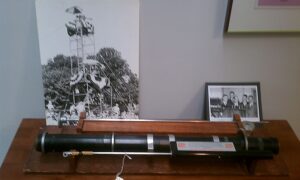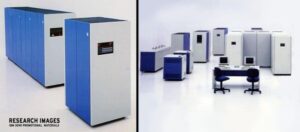Moore’s Law Published
 April 19, 1965
April 19, 1965
Electronics magazine publishes an article by Gordon Moore, head of research and development for Fairchild Semiconductor and future co-founder of Intel, on the future of semiconductor components. In the article, Moore predicts that transistor density on integrated circuits will double every eighteen months for “at least” the next ten years. This theory will eventually come to be known as Moore’s Law and has largely held true to this day. Controversy exists over whether Moore’s Law remains applicable, however time will tell just how long Moore’s Law will continue to remain true.
Zoom Lenses Come to TV
The first public demonstration of a prototype Zoomar lens is conducted inside Studio 3H at NBC’s Rockefeller Plaza headquarters in New York City. Invented by Dr. Frank G. Back, and promoted by investor film and television producer Jerry Fairbanks, the Zoomar lens would become the first commercially successful zoom lens. A version for film cameras would first be used by Paramount later that year to cover the 1947 World Series for newsreel production. The ability to use zoom lenses allowed for less expensive TV productions and also made television sports broadcasts more interesting and feasible. By the end of the decade, Zoomar lenses were in use in nearly one-third of television stations in the United States at the time. As new TV stations were popping up quickly during this era, the fact that by 1957 more than half of the TV stations then in operation owned Zoomar lenses was even more impressive.
First Megabit Chip in Commercial Product
Newspapers report that IBM’s Model 3090 mainframe has become the first commercial computer to use a megabit memory chip, 4 times the storage capacity of the then current generation of 256 kilobit chips. To give context to that amount of storage, it was reported that a megabit chip could store over 1 million bits of data, which translated to about about 100 double-spaced typewritten pages. At the time most personal computers were still using 64 kilobit memory chips.
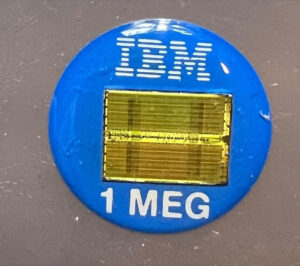 IBM wanted to make the announcement for two big reasons. First, the use of higher density memory could allow them to make their mainframe computers smaller, which would save their customers cost in floor space. But perhaps more importantly, they wanted to show that American technology companies in general and IBM in specific could keep up with Japanese companies in the highly competitive semiconductor market of the time. Lower-cost Japanese firms had captured 85% of the DRAM market and Fujitsu, Hitachi, Mitsubishi, NEC, and Toshiba were set to begin shipping megabit memory of their own. IBM was attempting to shed their reputation as being slow and stodgy as compared to the upstart Japanese. They even made promotional buttons with actual 1 megabit chips!
IBM wanted to make the announcement for two big reasons. First, the use of higher density memory could allow them to make their mainframe computers smaller, which would save their customers cost in floor space. But perhaps more importantly, they wanted to show that American technology companies in general and IBM in specific could keep up with Japanese companies in the highly competitive semiconductor market of the time. Lower-cost Japanese firms had captured 85% of the DRAM market and Fujitsu, Hitachi, Mitsubishi, NEC, and Toshiba were set to begin shipping megabit memory of their own. IBM was attempting to shed their reputation as being slow and stodgy as compared to the upstart Japanese. They even made promotional buttons with actual 1 megabit chips!
Osborne Executive Introduced
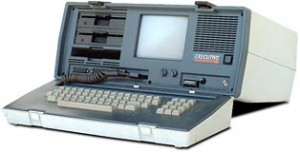 April 18, 1983
April 18, 1983
The Osborne Computer Corporation officially announced the Osborne Executive portable computer, the follow-up to its extremely successful Osborne 1. This is the computer that according to lore, took down the company. Known as the Osborne Effect, the legend is that by leaking the announcement of this computer earlier in the year, dealers cancelled all orders for the Osborne 1, effectively destroying the company’s cashflow and hindering operations going forward. This resulted in the cancellation of the company’s IPO and eventually to bankruptcy.
The reality may not be so simple, but my research shows that the Osborne Effect may have been a contributing cause to the company’s demise, along with the rise of competitors, the introduction of the IBM PC, and mismanagement by the company’s president, brought in by investors to provide “adult supervision”.
Surveyor 3 Launched
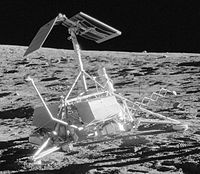 April 17, 1967
April 17, 1967
The spacecraft Surveyor 3 is launched from Cape Kennedy, Florida. It is the second U.S. spacecraft to make a soft landing on the Moon (Surveyor 2 crash landed) where it will study the lunar surface and send more than 6,300 pictures back to Earth. In all, seven Surveyors will be sent to the Moon, five of them successfully completing soft landings.
Apple and Commodore
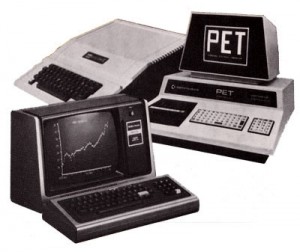 April 16, 1977
April 16, 1977
On the same day at the first annual West Coast Computer Faire, both the Apple II and Commodore PET 2001 personal computers are introduced. Ironically, Commodore had previously rejected purchasing the Apple II from Steve Jobs and Steve Wozniak, deciding to build their own computers. Both computers used the same processor, the MOS 6502, but the companies had two different design strategies and it showed on this day. Apple wanted to build computers with more features at a higher price point. Commodore wanted to sell less feature-filled computers at a lower price point. The Apple II had color, graphics, and sound selling for $1298. The Commodore PET only had a monochrome display and was priced at $795.
Note, it was very difficult finding a picture with both an original Apple II (not IIe) and Commodore PET 2001. I could only find this picture that also includes the TRS-80, another PC introduced later in 1977.
Marcel Brown Technology Services Born
 April 15, 2002
April 15, 2002
Budding entrepreneur Marcel Brown starts his first day as a full-time self-employed professional, after years of helping people and small businesses with their technology needs on the side. It was from this humble beginning that a technology empire of unprecedented scale was created.
Well, okay, maybe all of that’s not quite true yet, but with any luck, soon it will be!
PC Industry Born
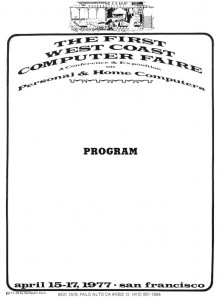 April 15, 1977
April 15, 1977
The first annual West Coast Computer Faire is held over three days in San Francisco, California, attended by 12,750 people. The Faire features the debut of the Apple II computer, which features 16KB of memory, BASIC, a built-in keyboard, eight expansion slots, and built-in high-resolution color graphics. Many credit this event and the launch of the Apple II as giving birth to the personal computer industry.
GE Founded
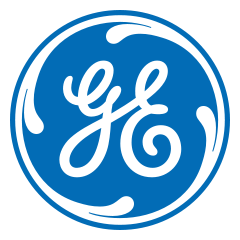 April 15, 1892
April 15, 1892
The General Electric Company (GE) is founded. It was formed by the merger of Edison General Electric (started by Thomas Edison in 1890) and the Thomson-Houston Electric Company. GE was one of the original 12 companies listed on the Dow Jones Industrial Average and in 2010 was ranked by Forbes as the world’s second largest company.
Columbia Lands
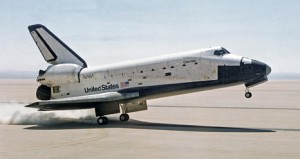 April 14, 1981
April 14, 1981
The first test flight of the first operational space shuttle, the Columbia, ends successfully as the orbiter lands at Edwards Air Force Base in California.

